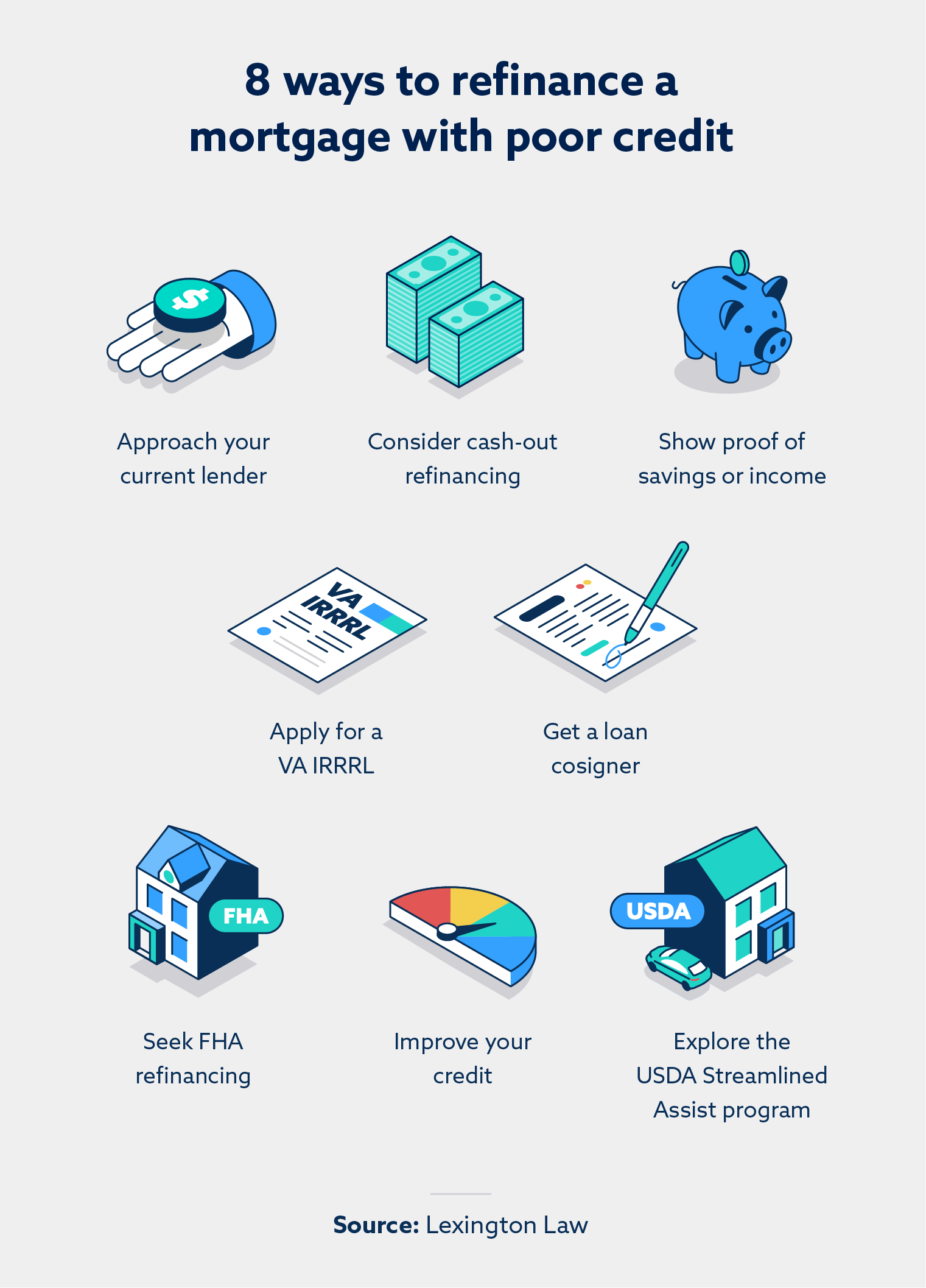
The information provided on this website does not, and is not intended to, act as legal, financial or credit advice. See Lexington Law’s editorial disclosure for more information.
You can refinance your mortgage with bad credit by shopping around for low rates, showing proof of income or savings, getting a loan cosigner, and improving your credit score. Other options include considering cash-out refinancing, applying for a VA IRRRL and seeking FHA refinancing.
Is it possible to refinance your mortgage with bad credit? The answer is yes, but it can be a complicated process. Because your credit rating is a significant aspect of any loan application and refinancing process, it’s in your best interest to consider all your options before moving forward.
Refinancing your mortgage can be an excellent opportunity to gain payment flexibility or even take advantage of a lower interest rate. To avoid leaving money on the table, explore the following options for refinancing with bad credit.
How to refinance your mortgage with bad credit

1. Talk to your current lender
When approaching your current lender about refinancing your mortgage, it’s essential to assess where you stand as a borrower. If you make payments on time and are in great financial health, the lender will likely want to continue doing business with you.
However, if you have been late on payments and are struggling to cover other financial responsibilities, the lender might be more reluctant to refinance your mortgage. To help with any negotiations, you should check with other banks to find the best interest rate you qualify for. Coming to your current lender after shopping around for prices will give you more bargaining power to get a lower rate.
2. Show proof of savings or income
Showing savings or reliable income can help lenders offer you a competitive rate. For lenders, any proof that a borrower can make payments toward a mortgage will lower the overall lending risk and positively impact the terms of the refinancing agreement.
3. Get a loan cosigner
If you have poor credit, you can use a loan cosigner. A cosigner promises to pay any outstanding debts if the borrower can’t pay. This is a big request, so think carefully before approaching someone.
4. Improve your credit
Before visiting your lender to inquire about mortgage refinancing options, you should look at your credit report to determine how to build your credit. If your credit report is full of negative items, there are probably some areas where you can make improvements. If any of the negative items are incorrect or false, you have a legal right to have them removed from your credit report. Some companies offer credit repair solutions that can help you on your credit repair journey, including filing disputes on your behalf.
In addition, you can work to make payments on time and in full and reduce your credit utilization ratio. Steps like this can have a long-term positive effect on your credit rating.
5. Consider cash-out refinancing
Cash-out refinancing is a mortgage refinancing option that’s ideal for people who owe less than their house is worth. It’s important to note that a cash-out refinancing option trades your current loan for a cash payment and a larger loan. Lenders can refinance a loan for up to 80 percent of the current market value.
The amount of money between what you currently owe and what your house is valued at can be a sizable help for short-term debts. Keep in mind, though, that you’ll still be responsible for paying back the new and larger loan in the long term.
6. Apply for a VA IRRRL
If you have an existing mortgage guaranteed by the U.S. Department of Veterans Affairs (VA), you can apply for an Interest Rate Reduction Refinance Loan (IRRRL) to help decrease your monthly payments.
You’ll need to meet the following requirements to qualify for the IRRRL:
- You have an existing VA loan
- You’re refinancing your VA loan
- You can prove that you live in or have lived in the home you’re refinancing
If your current mortgage isn’t a VA loan but you qualify for one, consider a VA-backed cash-out refinance to replace your existing loan. Remember that you must meet the service requirements to qualify for a VA loan.
7. Seek FHA refinancing
The Federal Housing Administration (FHA) has several refinancing options built to help homeowners with existing FHA-secured loans. Unfortunately, streamlined refinancing is not available for loans that originated outside of any Federal Housing Administration-secured lenders. One benefit of refinancing through the FHA is that credit and income checks aren’t part of the process.
If your mortgage is secured with the FHA, there are some prerequisites for the refinancing program:
- You’re current on payments and haven’t missed or been late on a payment for the past year.
- You’ve owned the house for over six months.
- You used an FHA-approved lender or an FHA-approved bank when refinancing.
If you’re still not sure you qualify, the FHA mortgage portal includes a step-by-step guide to estimate your best refinancing options.
8. Explore the USDA Streamlined Assist Program
The U.S. Department of Agriculture (USDA) Streamlined Assist program is a great option for borrowers with bad credit, since no minimum credit score is required. To qualify, you must have an existing USDA direct or guaranteed loan and have made on-time payments for the prior year.
Should you refinance your mortgage if you have bad credit?
You may be weighing whether to refinance now or wait until your credit improves. Here are some pros and cons to consider if you’re thinking about refinancing your mortgage and have bad credit:
Pros of refinancing
- Lowers your interest rate: In the event that interest rates have declined since you first got your mortgage, refinancing can help you obtain a better interest rate that saves you money long-term.
- Removes private mortgage insurance (PMI): If you provide a down payment that’s less than 20 percent of your home’s value, you’re required to get private mortgage insurance (PMI) that protects the lender in the event you miss payments. Most lenders require PMI until you have 20 percent equity. If your home has significantly risen in value since you took out your original mortgage, then you may have surpassed the PMI threshold.
- Provides cash-out equity to pay off high-interest debt: A cash-out refinance allows you to take out a larger mortgage that gives you access to the difference in cash. This money can be used to pay off high-interest debt or fund other expenses.
- Changes the terms of your loan: You have the option to refinance to a shorter or a longer loan term based on your current financial needs.
Cons of refinancing
- Requires you to pay closing costs: Most refinancing processes have a fee for processing the request.
- Risks savings loss: Just like refinancing at any other time, there’s no guarantee of savings, and many people end up in the same spot or with a loss in savings due to increased rates or loss of certain benefits.
- Escalates monthly payments or loan terms: For example, refinancing a 30-year to a 15-year mortgage will likely cause your payment to increase. On the other hand, refinancing from a 15-year to a 30-year mortgage will extend the amount of time you’re making payments.
- Possibly lowers your credit: Lenders will review your credit report as part of the application process, resulting in a hard inquiry, which may temporarily cause your credit score to take a minimal hit.

What credit score do you need to refinance?
The credit score you need to refinance your mortgage may depend on your loan type. Some loans, like an FHA refinance, require a significantly lower credit score than other loans, such as a USDA refinance.
Here’s a list of loan types and the minimum credit score required to qualify:
| Loan type | Minimum credit score |
|---|---|
| Conventional refinance | 620 |
| FHA refinance | 580 |
| VA refinance | No minimum credit score, but many lenders require at least 620 |
| USDA refinance | No minimum credit score, but many lenders require at least 640 |
| Jumbo refinance | 700 |
| Cash-out refinance | 620 |
How to improve your credit before a refinance
Alternatively, consider improving your credit before refinancing your mortgage with these steps:
- Review your credit report: First, read your credit report and look for any errors. If you notice any inaccurate information, send a challenge to the credit bureaus.
- Create a budget: Take note of your income and expenses, and look for ways to reduce expenses.
- Build an emergency fund: Often, people rely on credit cards for unplanned expenses. Instead, save up an emergency fund to help keep you on track during unforeseen circumstances.
- Lower your credit utilization ratio: VantageScore® recommends keeping your credit utilization ratio, which is how much credit you’re using compared to how much total credit you have available, under 30 percent.
- Pay your bills on time: Payment history is the most significant factor in determining your credit score, so never miss a payment deadline.
- Consider credit repair services: If you’re struggling to fix your credit, you can hire credit repair professionals to help you address inaccurate negative items impacting your credit.
In the end, there’s no one-size-fits-all answer to whether you should attempt to refinance your home. But know that it’s possible to refinance your mortgage with bad credit.
If you’re worried about your credit hurting your chances of refinancing, get your free credit assessment from Lexington Law to learn more about your current credit and how credit repair can help.
Note: The information provided on this website does not, and is not intended to, act as legal, financial or credit advice; instead, it is for general informational purposes only. Use of, and access to, this website or any of the links or resources contained within the site do not create an attorney-client or fiduciary relationship between the reader, user, or browser and website owner, authors, reviewers, contributors, contributing firms, or their respective agents or employers.
